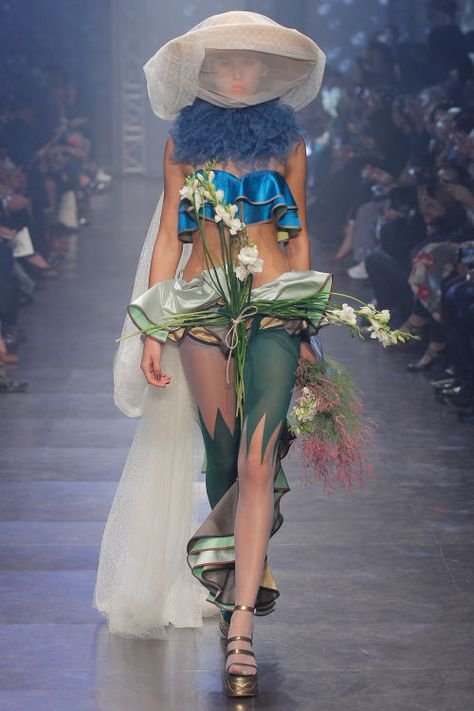Camp and Couture
Gay culture has long influenced the realms of fashion and beauty, with media having found much to feed off of in the dramas of catwalk and couture. When the eye of society is moved, all follows. Societal perception drives fashion, with icons continuing to shift, shape, and redefine perceptions of fashion and beauty. An icon who simply refuses to acknowledge the limitations of categorization is Vivienne Westwood. For decades, this trailblazer has continued to rule the industry, unrepentant in her quest for expression.
"I haven't told anyone this before, but when I was a teenager… I actually thought I was turning into a boy, and I didn't really care. It didn't bother me at all." – Vivienne Westwood
Kate Moss, Vivienne Westwood SS94, By Henry Benson
“‘[Gender] was never the most important thing for me,’ [Westwood explained], adding that her…collection…Unisex—which featured trousers for women and dresses for men—was more about playing with masculine and feminine proportions than about making a statement for gender identity.” It is clear that Westwood’s creation of fashion items, and what they come to represent, is something sourced from the mind of an activist. As well as growing her international fashion brand, whilst proving to be a high profile voice for environmentalism, anti-consumerism, technological advances, and human rights advocacy, Westwood weaponizes the limitations placed on fashion, instead of deconstructing society’s expectations of form. Westwood articulates the unresolved societal curses plaguing the modern world, utilizing fashion as a catalyst for cause and advocacy for progression. This can be seen in Westwood's fall 1994 ready-to-wear fashion show. The looks which flood this particular collection, along with many a Pinterest board, are constructed from bouffant, frilled, ornate, and embellished stylish compositions of fabric, unapologetic in their command of attention.
These extravagant pieces are linked together, absent of chaos and incoordination, through the blatant theme of an almost Georgianesque and eccentric style. Speaking on the limitations projected onto gender within visual culture, Westwood poignantly said, “Everyone has a masculine and feminine side; masculine qualities and feminine qualities. We've all got these sides to ourselves. And clothes can tell that story. People would think this is very unsympathetic, but I would always say to people, you don't actually need to go through with an operation, can't you just be? You are who you are! But then people say to me, 'Oh, you're really dreadful, how would you know?’”
Vivienne Westwood on Transgender Rights and Gender Fluidity in Fashion’, Olivia Fleming, May 19, 2015, ELLE
Vivienne Westwood ready-to-wear, Spring 2016
Another figure to note is Elsa Schiaparelli, who retired in 1954. In recent years of the brand’s life, Schiaparelli has presented us with couture designs donned by Linda Cardellini and Helen Mirren. Markedly, during her time in London, earlier on in her life, Schiaparelli recognized her passions for spiritualism, theosophy, and philosophy, perhaps this is where her taste for detail stemmed.
Hungarian-born American actress Zsa Zsa Gabor as she appears in the film Moulin Rouge (1952). The dress is one of Schiaparelli’s.
Opening her first studio in 1927, Elsa Schiaparelli made her style enigmatic, with elegant and enchanting flare marking her pieces. She famously collaborated with famed surrealists such as Salvador Dali, Leonor Fini, May Ray, and Jean Cocteau. Naturally moving from hats designed to look like upside-down shoes, to clothes made textured to depict skulls, Schiaparelli delved into material that was somewhat jarring to what the fashion world was accustomed to. Weaponizing bold color and acute technique, Schiaparelli had nations in awe with her works. Her use of her trademark, “shocking pink,” made some of her works instantly identifiable. Schiaparelli sourced her influences from the enigmatic and whimsical energy of artifice and the bizarre or obscure. Her incorporation of a sense of humor within her looks is what makes her work a foundation of camp fashion.
Imaginings of fantasy, identity, and appreciation of the obscure and or more unique compositions of style, conjure up none other than the legend Anna Sui. Reminiscence, nostalgia, and eccentricity are felt in much of her work echoing her experiences in downtown New York’s club scene. Sui allows her pieces to take on a carefree, often vibrant aura, so as to smoothly create a vessel to symbolize societal issues and incite discourse. Sui’s ability to create the illusions of fantasy, a foundation of the spirit of camp, proves to articulate the reasoning for her work and brand to live on.
Christy Turlington, Naomi Campbell, and Lina Evangelista - Spring 1994 ready-to-wear
There is definitely a clear feeling felt by those who live behind the chiffon curtain of the fashion industry: once one releases the pressure from society to dim their expressions of individuality, true freedom is obtained.
Alexander McQueen said it best: “Fashion should be liberation rather than imprisoning the ego.”




